Excerpts from Jim Conrad's
Naturalist Newsletter
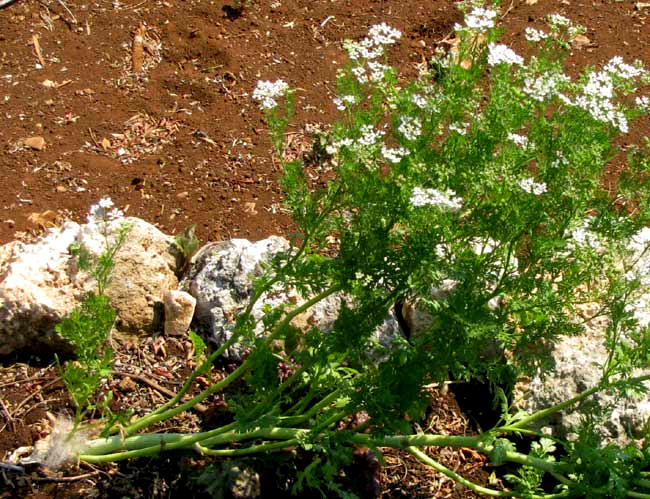
from the April 17, 2011 Newsletter issued from Hacienda Chichen Resort beside Chichén Itzá Ruins, central Yucatán, MÉXICO
CILANTRO/ CORIEANDER FLOWERING
Cilantro, or Coriander -- CORIANDRUM SATIVUM -- is such a commonly grown and used herb in Mexico that one tends to ignore it. This week, however, I had the good sense to pause awhile, admire and exchange vibes with some plants in the garden. You can see one of them, a plant that grew so tall that it fell over, above.
Cilantro belongs to the Parsley Family, the Umbelliferae, and one of the most diagnostic features of species in that family is that small flowers are clustered into "umbels" -- flat-topped flower clusters whose flower stalks, or pedicels, arise from a common point, like an umbrella's stays. Cilantro's flowers gather in "compound umbels," which means that secondary flower groupings, or "umbellets," are themselves held in umbels. You can see an umbellet below:

In that umbellet, notice that two outside flowers bear oversized petals growing outwards. These oversized petals distinguish Cilantro from other closely related and similar species. You can see some Cilantro fruits below:
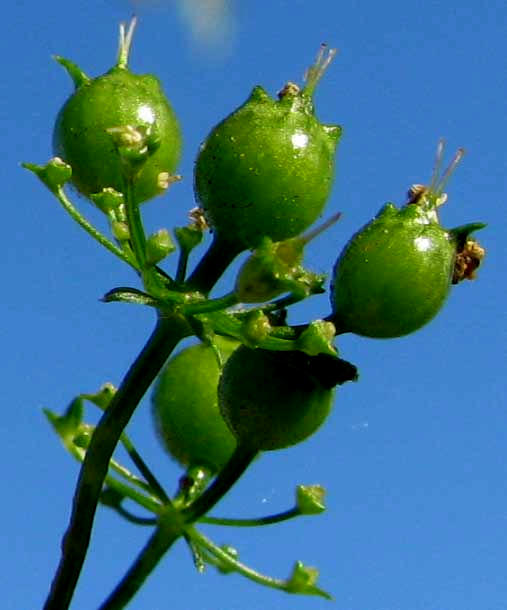
Notice the pale, slender styles still attached atop those fruits. Later they'll fall off. Technically, Cilantro fruits are "schizocarps," which are dry fruits that split into two halves, each half referred to as a "mericarp." A "ternately decompound" leaf, which I held against the sky admiring a good while, is shown below:
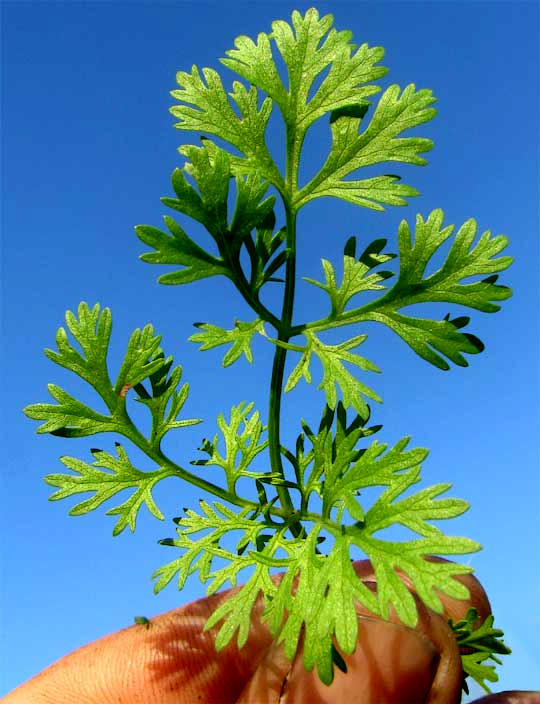
During my Cilantro-admiration time, Cilantro's pungent odor blossomed around me, reminding me of the wonderful Mexican salsas and guacamoles, and homemade gringo salads, I've enjoyed garnished with Cilantro leaves. When I took the fruit picture I thought of the fabulous sweet pickles my mother used to can in Mason jars, with Cilantro fruits serving as a pickling spice.
And finally I thought of Cilantro's medicinal uses, its antioxidants, its proven antibacterial activity against the cholera bacteria, its traditional use for diabetes, and more. Wikipedia's Coriander Page lists an impressive array of culinary and medicinal uses at https://en.wikipedia.org/wiki/Coriander.
Despite Cilantro being so important in Mexican cooking, it's not native, was instead introduced here by the Spanish. Originally it seems to have grown in the Near East and southern Europe, though it's been introduced into so many lands that its origin is hard to pinpoint. About half a quart of Cilantro mericarps were found in Tutankhamun's tomb. Even the Bible, in Exodus 16:31, mentions Cilantro, describing Manna as "round like Coriander seed... "
So, Cilantro qualifies as one of humanity's most enduring, useful and cherished herbs. To me its odor and taste go beyond mere sensory experience, into a realm where history, beauty and usefulness all meld into something transcendently "good."
from the March 24, 2007 Newsletter issued from Sierra Gorda Biosphere Reserve, QUERÉTARO, MÉXICO
DON GONZALO'S CILANTRO PATCH
A few weeks ago Don Gonzalo broke up a small patch of land near my casita and sowed cilantro, which is a member of the Parsley Family, in which we also find Cumin, Fennel, Parsnip, Carrot, Celery and other distinguished plants.
Don Gonzalo's seeds promptly sprouted and my first impression was that he'd sowed his seeds far too closely together. But now I see that he knew what he was doing. The plants are indeed crowded but, as such, they create their own microclimate, keeping individual plants relatively sheltered from the hot, dry-season air and sunlight. These plants aren't bolting and becoming scraggly, as they usually do when up north they're planted well spaced and in straight lines. You can see the Don's shaggy patch below:

I also thought Don Gonzalo had sowed far too much Cilantro, but now I see that he got that right, too. At lunch he opens up his tacos and heavily mulches his bean paste with shredded Cilantro, and he's not the only one who visits the patch. Sometimes the cleaning ladies go down and pick whole handfuls, take a break beneath a tree and nibble on their Cilantro bouquets as if they were bags of popcorn. The office workers sometimes collect it to sprinkle atop their meals and, of course, each day I throw a handful into my solar cooking pot.
Though Cilantro lies at the heart of traditional Mexican cooking, it was introduced into the Americas by the Europeans. Nor is Cilantro the only European food Mexican cuisine has wholeheartedly embraced. Olive oil, cinnamon, parsley, oregano and black pepper were all introduced by Europeans. They likewise brought in almonds, rice, wheat and barley, and fruit and vegetables such as apples, oranges, grapes, lettuce, carrots, cauliflowers, potatoes (these brought from Peru), and sugarcane. Nor had indigenous Mexicans ever seen horses, cattle, pigs, sheep, goats, or chickens.
On the other hand, Europeans had never heard of Mexico's chocolate, vanilla, corn or chili peppers.
from the April 23, 2017 Newsletter issued from Rancho Regenesis in the woods ±4kms west of Ek Balam Ruins; elevation ~40m (~130 ft), N20.876°, W88.170°; north-central Yucatán, MÉXICO
COLLECTING CILANTRO FRUITS
In order to have fresh Cilantro all the time, I plant small beds of it every three or four weeks. During my absence for the Kentucky trip a couple of my beds' plants dried up, but not before flowering and fruiting. Below, you can see the top of one of those dried-up-but-fruiting Cilantro plants:
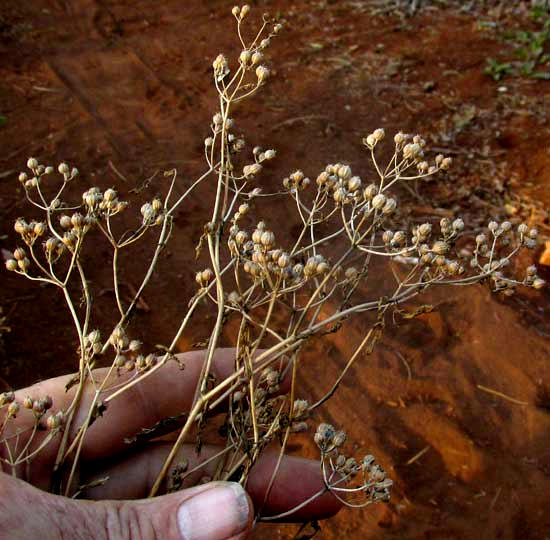
A fruit close-up is shown below:
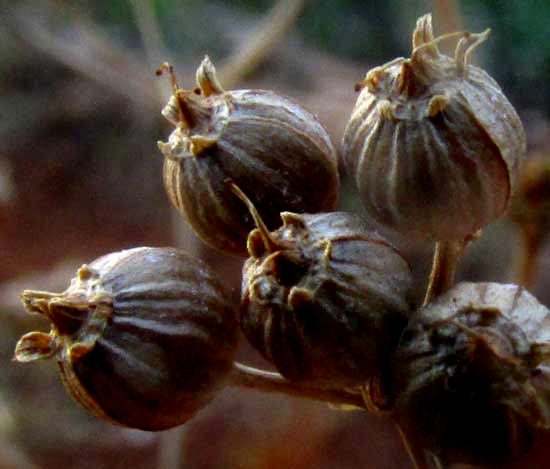
Harvesting Cilantro fruits is easy if you don't try to collect one fruit at a time. When the plants are dried out -- either after being hung to dry or after dying and drying out as they did here -- just rub the plants' fruiting heads between the palms of your hands, causing the dry parts to crumble onto a flat, clean surface you've spread below. You'll get a heap of fruits and broken stems looking something like what's shown below:

Pick out the largest stem sections, then blow away what chaff you can, and simply pour the remaining dry fruits into a jar that can be sealed against humidity and insects.
Technically, Cilantro fruits are "schizocarps," which are dry fruits that split into two halves, each half referred to as a "mericarp." Each mericarp contains one seed. Remember that Cilantro is a member of the Parsley/Carrot Family, the Umbelliferae, in which the flowers' inferior ovaries consist of two joined cells, or carpels. Each ovary matures into a fruit as each carpel matures into a mericarp.
Up north when we use "Coriander seeds," actually we're dealing with fruits. If we pick at wet Coriander fruits plucked from pickle juice, they'll break into two mericarps.